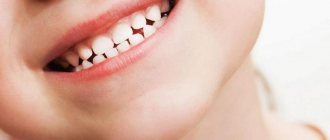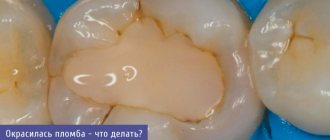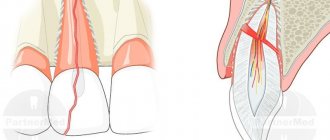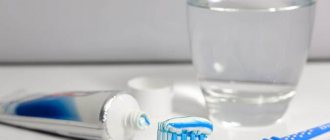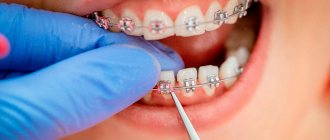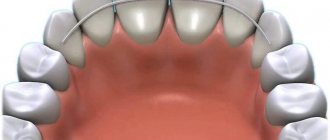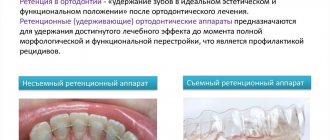Why do teeth hurt with braces? The fact is that during orthodontic treatment, a targeted physical effect is applied to the dental system, changing its usual state. The traction of the orthodontic arch causes irritation of the nerve endings, and the body’s response becomes unpleasant and sometimes very painful sensations. The degree of their severity depends on a number of factors - age, gender, clinical situation and individual reaction to stress. Therefore, doctors cannot offer a universal remedy to relieve patients of discomfort, but, of course, it is possible to alleviate the unpleasant sensations that arise at different stages of correction.
Does it hurt to get braces?
Depending on the chosen method of fixing the locks on the teeth, the procedure lasts up to 2–3 hours. It is not accompanied by painful sensations; the patient may experience some discomfort only from prolonged sitting in a chair.
But do not forget that before installing braces, the oral cavity is sanitized. It includes treatment of tooth decay and gum disease, as well as professional teeth cleaning to remove soft deposits and tartar. In some cases, in order to securely fix the braces, it is necessary to lightly process the tooth enamel. When performing the corresponding manipulations, painful sensations may occur, from which the patient is relieved by safe local anesthesia.
When should I expect pain to appear?
Before you decide to create a beautiful and attractive smile with the help of braces, you should learn more about this technology. It is carried out in stages.
- First of all, preparatory work is carried out. They include the treatment of dental caries and the removal of plaque from their surface. This is done in order to eliminate all problems associated with the integrity of tooth enamel and minimize the risks of gum disease. After all, braces are installed for a very long period, which can even be several years.
- Next, the bracket system is customized for each person individually, based on the shape and size of their jaws.
- The treating dentist fixes the breaker element on each tooth using special glue, after which all their clasps are connected to the arches of the bracket system. In this case, no pain should occur, since the work is carried out only on the surface of the teeth. Of course, the patient feels some discomfort due to a foreign object appearing in the mouth.
It should also be understood that the presence of a braces system in the oral cavity, attached to the teeth, requires special hygiene procedures and rules for eating, as well as following a certain diet. This is especially true for the most common version of braces – a permanent structure.
The work of the braces system consists of targeted pressure on a number of teeth through special arches. The strength and direction of this impact is adjusted by the doctor, using special screws, rubber rods or wire arches, depending on the design features of the braces. It is for this reason that teeth hurt when wearing braces for the first time after installation or a session of correcting their position.
Painful sensations in most cases directly depend on the force of pressure of the braces on the teeth. A highly qualified specialist with successful experience very accurately calculates the level of force so that the teeth are moved not only effectively, but also as painlessly as possible.
But even the most experienced doctor can cause pain with his actions. This happens when a person has a very low pain threshold. The patient must immediately inform his dentist about this. Based on this statement, the treatment schedule will be revised, the pressure of the adjustment screws will be reduced, and certain pain medications will be prescribed to reduce the pain from braces.
The patient often experiences pain after replacing the arches, but, as practice shows, it is quite mild and goes away quickly. Otherwise, you should immediately contact your doctor to resolve this problem.
How long do your teeth hurt after getting braces?
If your teeth or gums start to hurt after you got braces, don’t worry too much. Surely your doctor warned you that there may be pain at first.
Such unpleasant and painful sensations immediately after the installation of these orthodontic structures is completed is a completely natural phenomenon. Depending on the individual characteristics of the body, pain can be of varying degrees; there were practically no cases when the patient was able to avoid it.
Most importantly, you should not immediately blame the attending physician for the appearance of pain and discomfort, claiming that he installed the braces incorrectly and worked negligently. This is absolutely not true.
- First, each person has a different perception of pain and a certain level of patience to ignore it for a while.
- Secondly, it is easier to endure pain when you understand what caused it. To straighten the dentition, a certain amount of pressure is applied to each tooth. This, in turn, causes loosening of the row element with subsequent build-up of bone tissue. This whole process causes not only severe discomfort, but also quite severe pain. This adjustment period can last from several days to one or two weeks.
To minimize your suffering, you should visit your dentist so that he can prescribe the most effective painkillers for you.
After a certain time after taking these medications, the pain goes away, and the teeth, accustomed to the stress of the braces system, will not cause any discomfort in the future.
Recommendations on how to relieve pain from braces
To make the feeling of discomfort and pain due to such a foreign structure in the oral cavity as a brace system go away faster and easier, you should pay attention to the following tips:
- If severe pain occurs during the first time after installing braces, you should take painkillers strictly as prescribed by your doctor. As a rule, medications are taken after meals.
- If the design of the brace system irritates the oral mucosa, it is recommended to stick orthodontic wax on its surface. After three to four days, after you have gotten used to the braces, you don’t have to use wax.
- You can get rid of pain quite successfully by simply rinsing your mouth with salted water or other similar solutions. It is advisable to carry out this procedure several times throughout the day.
- If damage to the mucous membrane has occurred and a wound has formed on the oral cavity, then it is necessary to immediately apply medications that promote wound healing and relieve pain.
After installing braces, you should pay close attention to the range of products that are included in your daily diet. You should definitely avoid chewing gum and seeds, fresh carrots and green apples, hard cheese and sausages, as well as other products that can clog and clog the space between the tooth enamel and the brace system structure.
It would be optimal to stick to a diet with light first courses, various cereals, steamed vegetables and meat while wearing braces. Today you can find many delicious dishes, the recipes of which are perfect for people with installed braces.
Why do my teeth hurt after getting braces?
Discomfort is caused by two reasons.
- The orthodontic arch puts a lot of pressure on the teeth. When changing position, they, in turn, affect the ligaments, causing them to compress on one side and stretch on the other, and on bone tissue. When developing a treatment program, the orthodontist tries to calculate the traction force of the arch so that the correction is effective and the pain is tolerable.
- During the adjustment period, protruding elements of the braces system can injure the mucous membranes of the cheeks, tongue and lips. The patient will be given orthodontic wax and given instructions on its use. Applied to problem areas, wax will protect the mucous membranes from chafing and irritation, significantly reducing discomfort.
Why pain in braces is “normal”
Painful sensations tell us that the tooth is being impacted. This is how it moves. This process involves both soft gum tissue and the bone base of the jaws.
And if soft tissues easily adapt to the new position of the tooth and heal quickly, then bone tissues cannot change so quickly and hurt longer.
It is important to understand that this pain is not associated with the destruction of the tooth, but with its movement to a new, even position.
Interaction with the iron ligature of braces can also cause small ulcers in the mouth that irritate. Such irritation and even damage to the mucous membranes is caused by the metal parts of the brace system. These wounds go away quite quickly after the oral cavity adapts to the device. But they may not pass, as for example in this case:
We can say that the mucous membrane adapts to such external effects of metal. As they say, everyone has to get used to and come to terms with the fact that now they will have to wear braces on their teeth for a year or two.
Why do my teeth hurt from braces after activating treatment?
Painful sensations return for several days when the system is activated. After a certain time, the teeth are aligned, the bite is corrected, the ligatures are stretched, and the force of the arc decreases. To restore the effectiveness of ligature braces, the doctor periodically corrects them:
- after 3–4 weeks, renews ligatures;
- after 2–3 months, replaces the arch;
- At each appointment, checks the secure fastening of the locks.
Self-ligating systems need to be activated less frequently. The severity of pain depends on the individual pain threshold and the condition of the dental system. Typically, teeth respond to the next increase in traction within 2–3 days.
General conclusion
The unknown is worse than real treatment. Correction with braces does not cause discomfort if installed correctly and following the doctor’s recommendations.
In the orthodontic studio of Leonid Gorbunov, bite correction is carried out using high-tech brace systems from world brands. Attentive, qualified specialists carry out installation accurately and delicately. If complaints arise, you can always contact an orthodontist and adjust the intensity of the impact. A beautiful, healthy smile after wearing braces justifies the minor inconveniences during treatment.
Posted by:
Why do my teeth hurt after braces are removed?
The procedure for removing the system is painless. After removing the archwire, the attending physician, using a special tool, removes the clasps and polishes the enamel to remove any remnants of the fixing compound.
In some patients, the enamel may become especially sensitive after wearing braces. It will react to hot and cold drinks and foods, salty and sour foods, etc. To prevent the appearance of hypersensitivity, it is restored with the help of special gels, varnishes and toothpastes.
After the braces are removed, the teeth that are lined up in an even row will try to return to their previous position. This may also cause pain. To maintain the results of treatment, patients have to wear a so-called retainer. A non-removable plate attached to the inside of the teeth or a transparent removable mouthguard will hold the teeth in the desired position, secure the result of the correction and relieve discomfort.
What will help you cope with pain?
If you follow all the doctor's recommendations and properly care for your teeth and braces, pain may not occur at all, only some discomfort.
If the pain does not go away, then it is worth checking how the braces are installed; perhaps some mistakes were made that only a doctor will correct.
What other recommendations might there be for patients experiencing pain in braces?
- Dietary restrictions - switching to liquid and pureed foods. - How do you like this option?
- Treatment of braces with dental wax.
- Take painkillers only as prescribed by a doctor!
Diet restrictions
If you have braces, be prepared to change your diet and avoid foods that are hard, fibrous, or too hot or cold. Because this can break your braces, damage your teeth, or increase pain.
After installing the system, you should wait at least one hour before you can eat liquid or soft food. Soups, pureed porridge and even baby food are the basis of your diet during bite correction. And, by the way, you will have to brush your teeth very, very carefully, since food will constantly get stuck there, forming plaque:
Special wax
In pharmacies you can buy orthodontic wax, which is applied to braces and helps reduce pain from friction and pressure of the device on the mucous membranes and teeth.
Taking painkillers
Any medications, even the seemingly safest ones, should be used only after consultation with a specialist and after carefully reading the instructions, contraindications and side effects of these medications. By mindlessly taking any medications, you can only seriously harm yourself, always remember this!
For irritation of the mucous membrane, rinsing with chamomile decoction helps a lot. Of course, with one “but” - if you are not allergic to it.
CONCLUSION
: In case of any incomprehensible sensations, we recommend that you contact your doctor so as not to miss serious points during treatment.
We still have one important question, which we promised to answer at the very beginning of the article, here it is:
How to relieve toothache from braces?
- Take the pain reliever at the dosage prescribed by your doctor and at the recommended frequency.
- Use local anesthetics - gels and mouthwashes that dull the pain for a couple of hours.
- Baths with warm salt water soothe pain and heal abrasions of the soft tissues of the oral cavity. The solution should be kept in the mouth for about a minute, and the procedure should be repeated several times a day.
- Relieve inflammation by rinsing or bathing with 3% hydrogen peroxide, which has an antiseptic effect. The 1:1 solution is also kept in the mouth for about a minute. You can also buy a ready-made peroxide-based rinse at the pharmacy.
- Use specialized wax as needed. After tearing off a piece, roll it into a pea, dry the problematic metal element with a napkin and press the pea onto it.
How can you avoid pain with braces?
ANSWER: Very simple - aligners. A - not braces. This should be your normal choice for correcting your bite. Aligners have long proven to everyone - both doctors and patients - that they have a huge number of advantages over braces.
And with aligners, you don’t need to be afraid of pain for the simple reason that there is NO pain there.
How to relieve pain at home
Pain appears when installing braces and when changing the arch. You can reduce it at home in several ways:
- Taking painkillers (consultation with a doctor is required!)
- Application of lidocaine gel
- Eating cold food
- Applying a cold compress
- Rinsing your mouth with salt water
To prevent attacks of toothache and keep your teeth in good condition, you need to buy:
- Irrigator
- Brushes for braces
- Mono-beam brush
- Orthodontic brush
- Medical wax
Alternative techniques
In cases where the problem of tooth sensitivity is pronounced, alternative methods for correcting malocclusion can be used. The use of removable aligners allows not only to avoid these symptoms, but also to eliminate such a serious drawback of treatment with braces as a violation of aesthetics. Aligners are effective, comfortable, and invisible to others. In addition, their use allows you to perform hygiene procedures in full.
However, no matter what method of bite correction the patient uses, to obtain the desired effect, the professional qualities of the orthodontist are the priority. Specialist Irina Aleksandrovna Butorina has the highest qualifications and extensive practical experience, which allows her to find the most optimal solution in each case and obtain the desired result even with increased tooth sensitivity.
When to see a dentist
To effectively straighten your teeth, you should regularly tighten your braces. You must visit the doctor every month. In difficult cases, this is done every 2 weeks. Self-ligating braces allow you to visit the dentist once every 2 months.
To get a beautiful smile, you need to follow all recommendations and visit dentists at every opportunity.
If you have not yet chosen your braces system, contact our dentists.
We have qualified orthopedists and the most attractive prices for braces. Sapphire braces, metal braces, non-ligature braces and many others - you can discuss each option with your doctor, choosing the best one! The doctor's consultation
Getting used to braces
The hardest part will be getting used to braces. You will feel discomfort and pressure on your jaw. How long this will last depends on your sensitivity. Typically, getting used to braces takes from 3 days to 2 weeks.
- Please be patient
. One day you will get used to the braces and they will stop bothering you. It will become easier to eat, speak and brush your teeth. - If the structure cuts the inside of the cheeks
, you can cover it with special wax or silicone. - diction problems
appear , then do not worry - when you get used to it, you will begin to speak as before.
If you feel severe pain or it seems to you that some part of the structure is seriously injuring the mucous membrane, call the orthodontist. It will adjust the system, and the addiction will be easier.
You will also have to get used to braces psychologically. Don't be shy. Many people now have orthodontic systems installed. You can meet them in everyday life and among celebrities.
To prevent the period of adaptation and wearing the system from causing severe inconvenience, adhere to the recommended diet and properly care for the oral cavity and structures.
Preventive actions
To exclude negative phenomena, before installing braces, it is necessary to determine with the orthodontist the nature and mechanism of hygienic procedures, and clarify the necessary means. This is especially acute in cases where the patient initially notes increased sensitivity of the teeth. If such symptoms occur during treatment, it is also necessary to discuss the problem with a specialist. Carrying out regular hygiene procedures in the dental office helps prevent such undesirable phenomena.
Elastic bands for braces (traction)
Elastic bands for braces or traction are elastic rings that create additional load and reliably fix the arches to the braces, speeding up treatment.
There are several types of traction.
- Elastic
- rings that are put on braces installed on both the upper and lower teeth. The patient can change them himself. - Ligature rings
are small in diameter rings that are installed on each bracket to combine the plates with the arch into a single structure. - Chain rings
- they are connected alternately to form a chain. They are placed to eliminate wide interdental spaces.
